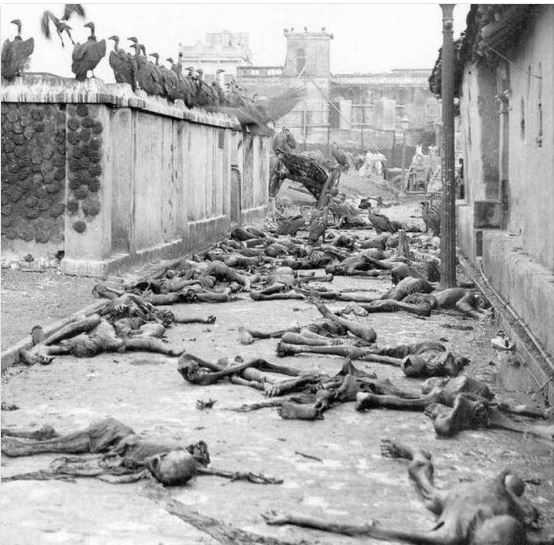Original post here: https://newint.org/features/2021/12/07/feature-how-british-colonizers-caused-bengal-famine

The mass starvation that killed three million Indians during the closing years of the Second World War was no act of nature; it was engineered. Britain must face up to this crime, says Jason Hickel.

The Bengal famine stands as one of the single most horrific atrocities to have occurred under British colonial rule. From 1943 to 1944, more than three million Indians died of starvation and malnutrition, and millions more fell into crushing poverty.
For many years, the British blamed the famine on weather conditions and food shortfalls, as if it were an unavoidable natural disaster. Today, most researchers agree that the crisis was human-made, triggered primarily by war-time inflation that pushed the price of food out of reach.
Britain has been accused of not doing enough to alleviate the famine. But recent research by the economist Utsa Patnaik suggests there’s more to this story. Her work reveals that the inflation wasn’t incidental, as most have assumed, but a deliberate policy, designed by the British economist John Maynard Keynes and implemented by Winston Churchill, to shift resources away from the poorest Indians in order to provision British and American troops and support war-related activities.
To understand what happened during the 1940s, it’s important to grasp that it came on the heels of nearly two centuries of colonial plunder. From 1765 to 1938, the British government extracted goods worth trillions of dollars in today’s money, which were either consumed in Britain or re-exported for profit.1 This windfall was used to build domestic infrastructure in Britain, including roads, factories and public services, as well as to finance the industrialization of Western Europe and British settler colonies. Development in the Global North was funded in large part by colonial extraction.
HUNGER BY DESIGN
For Indians this system was devastating. As colonial extraction intensified, India’s per capita consumption of food grains collapsed from 210 kilograms per year in the early 1900s down to 157 kilograms per year by the end of the 1930s – what Patnaik refers to as ‘severe nutritional decline’.
What happened during World War Two exacerbated this situation considerably. As US and British troops poured into Bengal to stage military operations against Japan, the colonial government decreed that, on top of existing mechanisms of extraction, all costs associated with Allied activities in the region would be covered by Indian resources, to an unlimited extent, until the end of the war.
Keynes sought to devise a mechanism for shifting resources away from the local population in order to provision military expansion
Keynes, who was a special advisor on Indian financial and monetary policy to Churchill and the Chancellor of the Exchequer, was actively involved in planning war-time funding strategies. He sought to devise a mechanism for shifting resources away from the local population in order to provision the military expansion. One option was to tax rich people, but there weren’t enough of them to provide a sufficiently large resource base. The alternative was to tax ordinary people, but Keynes knew that imposing any direct taxation on a population that was already immiserated would likely trigger riots.
So he advocated for an indirect tax, through deliberate inflationary policy. Here’s how it worked. During the 1940s, the colonial government printed extraordinary amounts of money for military expenditure. All this new demand caused prices to soar, particularly for staple goods. The price of rice increased by 300 per cent. But because wages did not rise accordingly, ordinary people were pushed even deeper into poverty, forcing them to dramatically curtail their consumption of food and other goods. Meanwhile, any additional profits that fell into the laps of business owners as a result of the price inflation were taxed by the colonial state.
The inflation was no accident. The impoverishment was no accident. British policy was explicitly designed to ‘reduce the consumption of the poor’, as Keynes put it, in order to make resources available for British and American troops, through a ‘forced transfer of purchasing power’ from ordinary people to the military. The austerity was imposed most harshly on the people of Bengal, who fell into extreme famine, while food supplies were appropriated and diverted for military use.
In the name of the Allied cause, the policies imposed by Keynes and Churchill killed more than three million people – many times more than the total number of military and civilian casualties suffered during the entire war by Britain and the US combined. The scale of this tragedy is almost impossible to fathom. If laid head to foot, the corpses of the victims would stretch the length of England, from Dover to the Scottish borders, nearly 10 times over.
Keynes is celebrated as a progressive; but he was also an imperialist, who promoted the narrative of a ‘white man’s burden’ to rule over ‘subject races’ for their own good
During this crisis, a number of officials in India pleaded with Churchill to send aid, but their requests were repeatedly refused. Instead, quite the opposite happened: the British government continued to extract income from India for its own domestic spending, totaling as much as £15 billion ($20 billion), in today’s money, from 1939 to 1944.
Patnaik points out that this intervention cannot be justified in the name of the war effort. Keynes and Churchill chose to finance Allied actions by appropriating food and other resources from colonized peoples, who had no say in the matter – but they could have done it in other ways. For instance, the US and Britain could have used their own resources instead, which would have required taxing their own citizens at no more than £1 per person.
TAINTED LEGACY
This history forces us to reflect on the legacy of figures that are widely celebrated today. It has long been understood that Churchill held white supremacist views. In a 1902 interview, he claimed that ‘the Aryan stock is bound to triumph’ over ‘the great barbaric nations’. He referred to Indians as a ‘foul race’, a ‘beastly people with a beastly religion’. During the Black Lives Matter protests of 2020, there were calls for Churchill’s statue to be removed from Westminster. Boris Johnson, an admirer of Churchill, refused on the grounds that we shouldn’t ‘edit’ Britain’s history. If that’s the case, then we should ensure that the full story of Churchill’s legacy is told – and alongside every statue of him place a memorial to the three million Indians who were killed by his policies and to whom the Allied victory is ultimately owed.
Keynes, for his part, is a more complicated figure. He is celebrated as a progressive; but he was also an imperialist, who promoted the narrative of a ‘white man’s burden’ to rule over ‘subject races’ for their own good. He was actively involved in governing colonial India and condemned the Indian revolt of 1857. When he set up the World Bank and International Monetary Fund in 1944, he ensured that India and other colonies were integrated into the system on unequal terms, with only a fraction of the voting power that Britain and the US would hold – an arrangement that remains in place to this day. Patnaik’s research adds to this picture by revealing his role in perpetrating the Bengal famine. This is a crime that needs to be confronted.
What is required of Britain in light of this history? An apology, to be sure – which to date has never been proffered. But this is also a straightforward case for reparations. Germany has sought to make reparations for the Shoah and for the Herero-Nama genocide, and rightly so. Why shouldn’t Britain do the same?
Notes
1Patnaik and Patnaik calculate that the absolute value of the drain from 1765 to 1938 amounted to $10.5 billion (not adjusted for inflation), which is more than India’s GDP at the end of that period. They note that if the value of drained goods had been invested at 5% per year, it would have amounted to $1.95 trillion in 1947 and, carrying on the thought experiment, $66 trillion in 2020.
Correction: A previous version of this article suggested that the famine was initially blamed primarily on drought; it has been amended to acknowledge that it was blamed on adverse weather conditions more broadly. In addition, a footnote has been added to explain Patnaik and Patnaik’s calculations of the drain from colonial India.
This article is from the January-February 2022 issue of New Internationalist.




